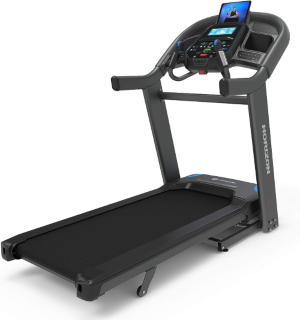Updated: January 19, 2024
Runners and committed walkers don’t have to be beholden to a subscription training service on the Sole F80 or the Horizon 7.4 AT treadmills. These treadmills support a similar amount of training with their powerful motors and spacious running decks. This treadmill comparison of the Sole F80 and Horizon 7.4 AT examines their features and construction to help you choose the better fit for you. While these treadmills are both folding residential treadmills, many differences set them apart.

Sole F80 Highlights
- The Sole F80 has a sleek z-shaped frame.
- The F80 is best for road runners trying to match their outdoor training pace.
- The Sole F80 has a hand-release lever.
- The F80 has a 10.1” touchscreen.
- The Sole F80 has good speakers and Bluetooth audio.
- The Sole F80 has a wireless charging pad.
- The Sole F80 has third-party streaming apps from Netflix and more.
Horizon 7.4 AT Highlights
- The Horizon 7.4 AT’s warranty on parts and labor are longer.
- The 7.4 AT’s speed and incline adjust very quickly.
- The 7.4 AT uses 3-zone variable cushioning for a soft landing and firm push-off zone.
- The 7.4 AT folds compactly.
- The incline range is 0 to 15%.
- The QuickDial controls are intuitive to use.
- The 7.4 AT comes with a Bluetooth HR monitor.
Sole F80 Treadmill Specs
- Footprint: 82.5” x 38” x 66”
- Deck Size: 22” x 60”
- Motor Size: 3.5 HP
- Weight Capacity: 350 lbs
- Product Weight: 274 lbs
- Speed Range: 0 to 12 mph
- Incline/Decline Range: 0 to 15%
- Cushioning: Cushion Flex Whisper Deck; firm
- Roller Size: 2.36”
- Warranty: lifetime frame and motor; 3-year parts; 1-year labor
Horizon 7.4 AT Treadmill Specs
- Footprint: 76” x 37” x 63”
- Deck Size: 22” x 60”
- Motor Size: 3.5 HP
- Weight Capacity: 350 lbs
- Product Weight: 318 lbs
- Speed Range: 0.5 to 12 mph
- Incline/Decline Range: 0 to 15%
- Cushioning: 3-zone variable response cushioning; firm
- Warranty: lifetime frame; lifetime motor; 5-year parts; 2-year labor
Treadmill Comparison of The Sole F80 vs Horizon 7.4 AT
Build Quality
Horizon and Sole both make sturdy running treadmills. However, Sole has the more modern construction. The Sole F80 has a more streamlined appearance while the Horizon 7.4 AT sticks to a traditional treadmill look. Both builds are sturdy during walking and running and can support a maximum user weight of 350 lbs.
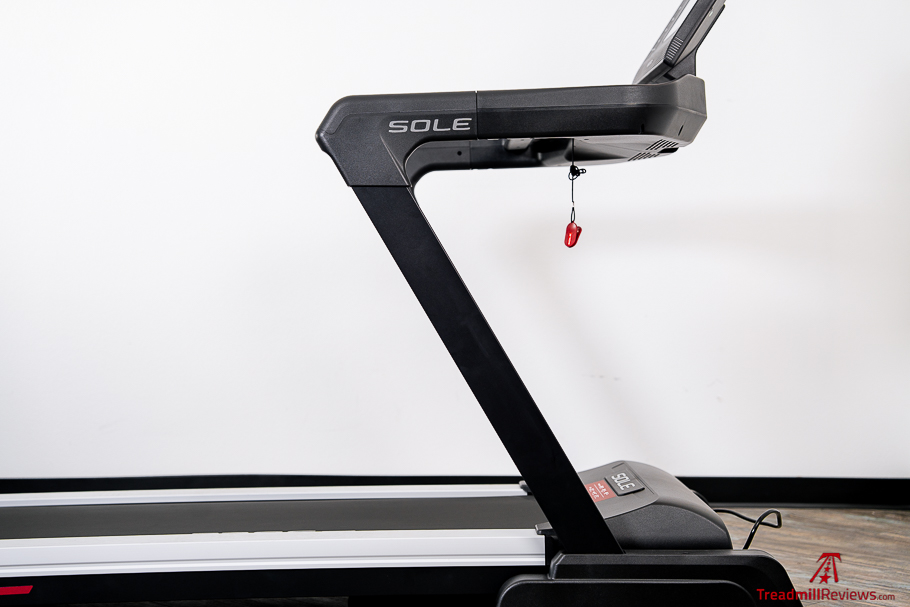
Both treadmills’ frames and motors are covered by a lifetime warranty. The Sole F80 has a 3-year parts and 1-year labor warranty while the Horizon 7.4 AT has a 5-year parts warranty and 2-year labor warranty.
Frame
Both treadmills have sturdy metal frames. These treadmills were both built to support running. The Horizon 7.4 AT has large steel uprights to support its large rounded console. The uprights are reinforced with a crossbar. The footrails are textured to improve traction, and the handrails are metal with a slightly gritty texture.
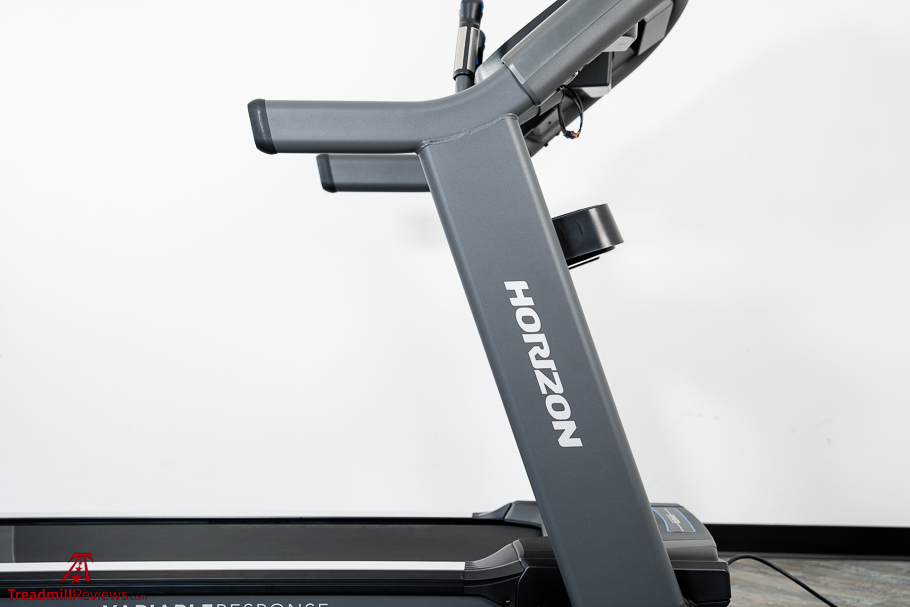
The Sole F80 has angled uprights with a floating console design. Like the 7.4 AT the footrails are textured for improved traction. The handrails on the F80 are covered in plastic and slightly textured. The F80 has a stability bar in front of the console.
Overall, these treadmills have impressive builds. The frame is very supportive on both. While I think the functionality of the Horizon 7.4 AT, I know a lot of shoppers are looking for a modern and clean aesthetic for their treadmill. I have to go with the Sole F80 for its ability to modernize while keeping a stable build.
Motor
The Sole F80 and Horizon 7.4 AT have 3.5 horsepower motors. Their noise levels are very similar. The only difference between these two treadmills’ motors is the responsiveness. Horizon has a reputation for making treadmills with fast speed and incline adjustments. I expect the 7.4 AT to adjust faster than the F80. While I have to go with the 7.4 AT here, both treadmills are good for walking and running short and long distances.
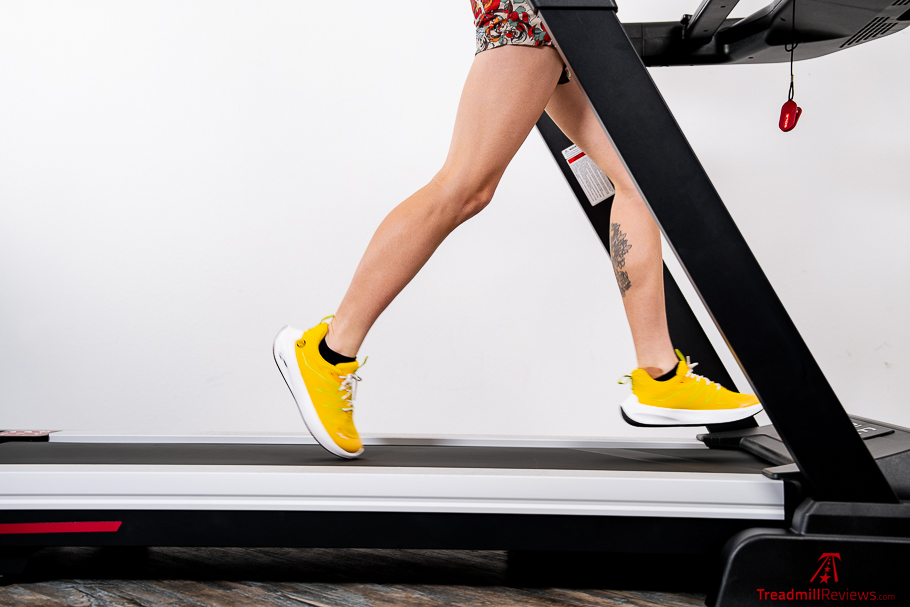
Running Surface
A 22-inch by 60-inch running deck used to be standard for home treadmills. In the last few years, many treadmills have adopted a more compact 20-inch width but not the F80 or 7.4 AT. These treadmills both have spacious running decks with plenty of room to stretch out your stride, even if you have a wider step width or tend to move side to side.
The difference between these treadmills becomes apparent when you test out the cushioning. The 7.4 AT has 3-zone variable cushioning, which is softer in the front and firmer toward the back of the treadmill. This gives you plenty of shock absorption upon landing and a firm push-off in the back. We rate the 7.4 AT as having moderately soft cushioning. The F80, on the other hand, is firm. While both cushioning types have advantages, the 7.4 AT’s higher shock absorption may feel better to most users.
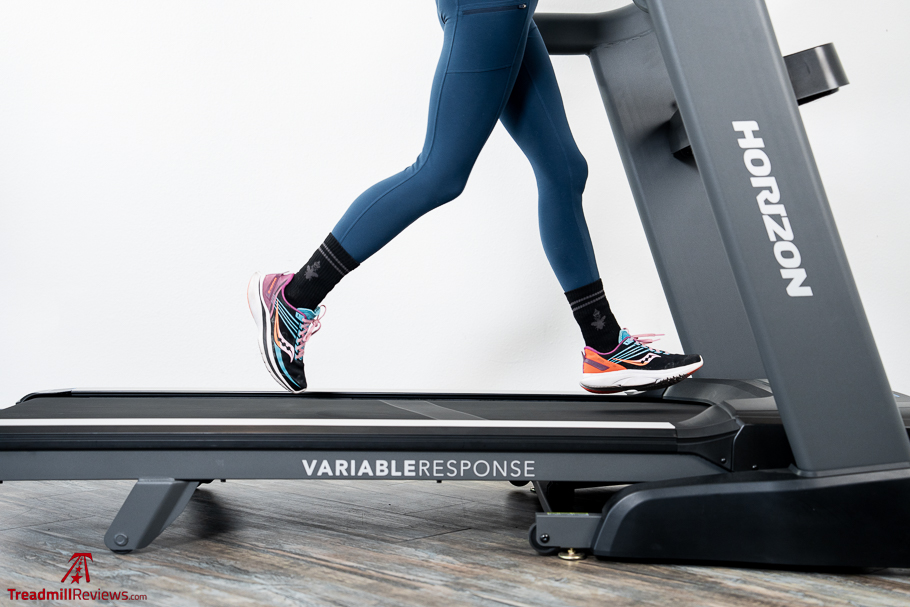
Folding/Storage
The Sole F80 and the Horizon 7.4 AT fold compactly for easy storage. The F80 uses a gas shock and a hand-release lever to softly lower the treadmill to the ground. The 7.4 AT uses a kick-release lever and hydraulics to do the same. I like the F80’s hand-release lever a little more, because it does not require you to balance on one foot, which may be challenging for some users.
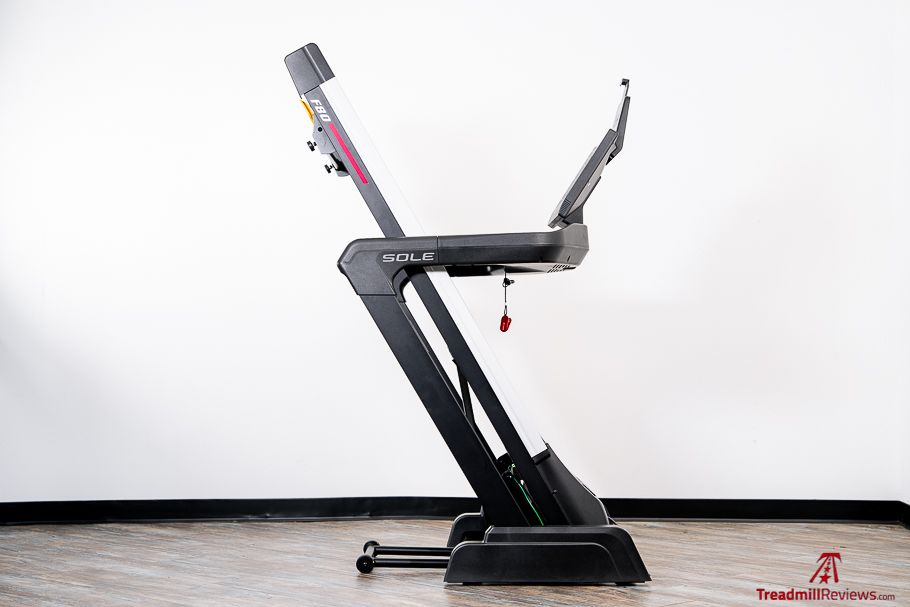
The F80’s folded dimensions are 44” long, 38” wide, and 71.5” high. The 7.4 AT’s are 42” long, 37” wide, and 71” high. These measurements are very similar with 7.4 AT coming out just a little more compact.
Incline/Decline
The Sole F80 has 15 levels of incline and no decline. However, the 15 levels of incline do not equal a 15% incline. The F80 only inclines to about 12%. The Horizon 7.4 AT inclines to 15% and does not decline. The 7.4 AT’s speedy incline adjustments and larger range conquer this category.
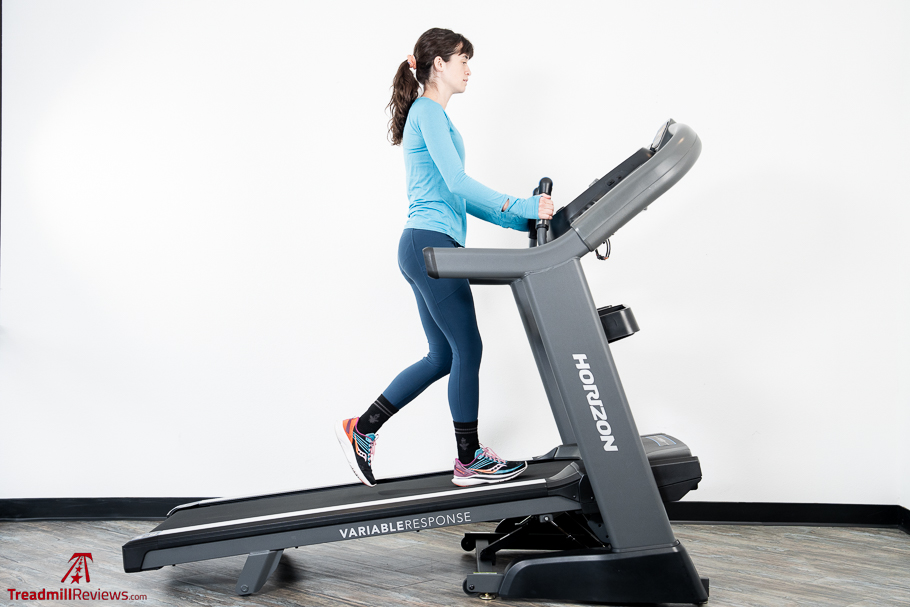
Features & Accessories
Now, you may be considering the Horizon 7.4 AT over the Sole F80 at this point. However, the scales are about to tip in the F80’s favor if you are looking for high-tech features. The F80 is a smart treadmill, but the 7.4 AT is a better pick for users who do not want to connect to WiFi or use a touchscreen.
Console Overview
Before we get into the most fun features, let’s go over the buttons. I am not the biggest fan of the F80’s button options, because they skip popular speeds and incline levels. The incline and speed switches provide a secondary method for adjusting the speed and incline, but they are not quite as nice as the QuickDial controls on the 7.4 AT. The dials adjust speed and incline with just a swipe. They feel really similar to the Peloton Tread’s dials. The 7.4 AT also has buttons for each speed and incline level.
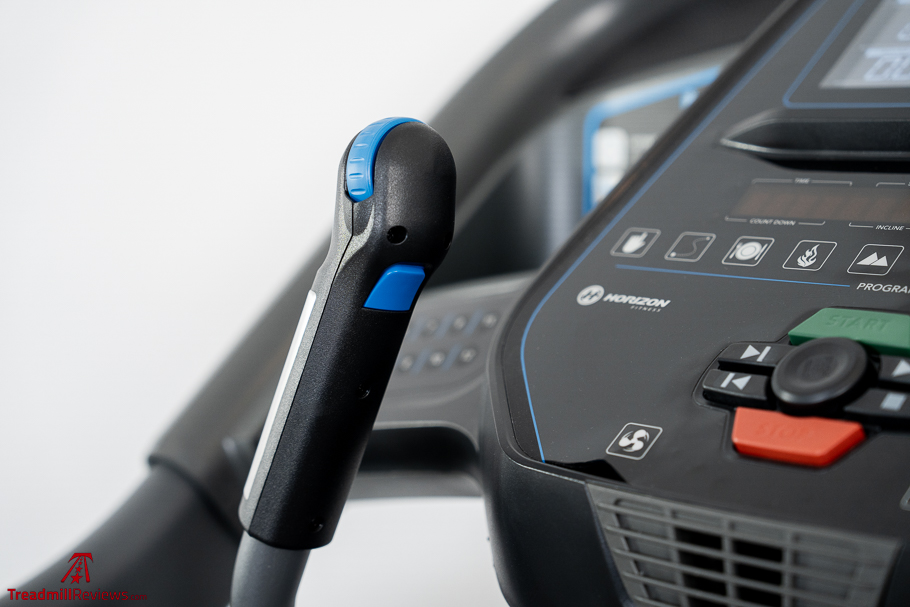
Screen
The Sole F80 has a 10.1-inch touchscreen display. It has way more functionality than the Horizon 7.4 AT’s 8.25-inch LCD screen and 16 LED windows. There are loads of content options for the F80, which I will get more into later. The F80’s screen size is easy to view and navigate. You will need a WiFi connection to use most of the F80’s features, whereas the 7.4 AT is better for low-tech users without WiFi.
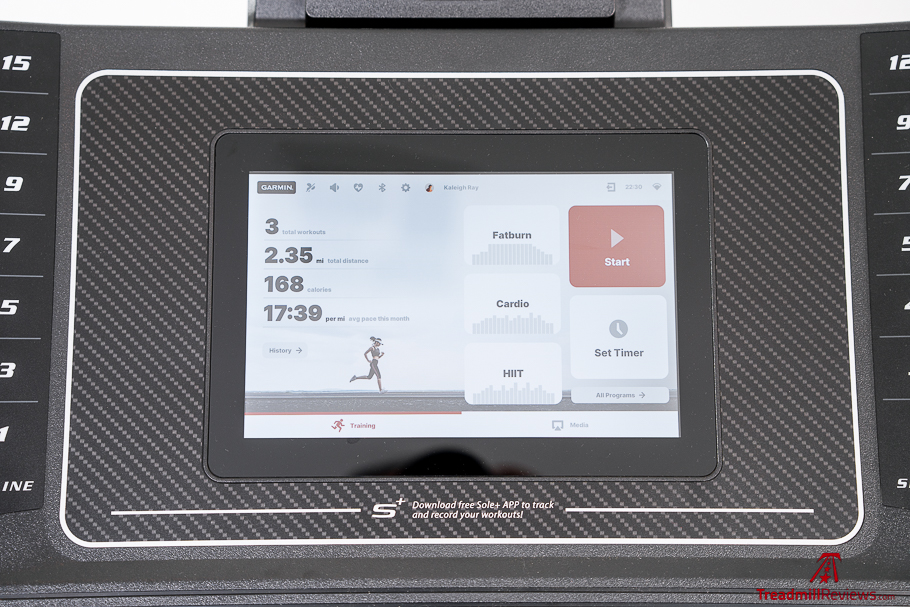
Speakers and Audio
The Sole F80 has better audio speakers than the Horizon 7.4 AT. The Sole F80’s speakers play audio for the onscreen content and connect to your device for Bluetooth audio. Alternatively, you can pair headphones with the F80 to listen quietly.
The Horizon 7.4 AT’s speakers can connect to your phone or tablet via Bluetooth or an auxiliary cord. The sound and volume are not as good as the F80’s, but they work well enough. You can use the speakers to play music, entertainment audio, trainer instructions from your favorite apps, and more.
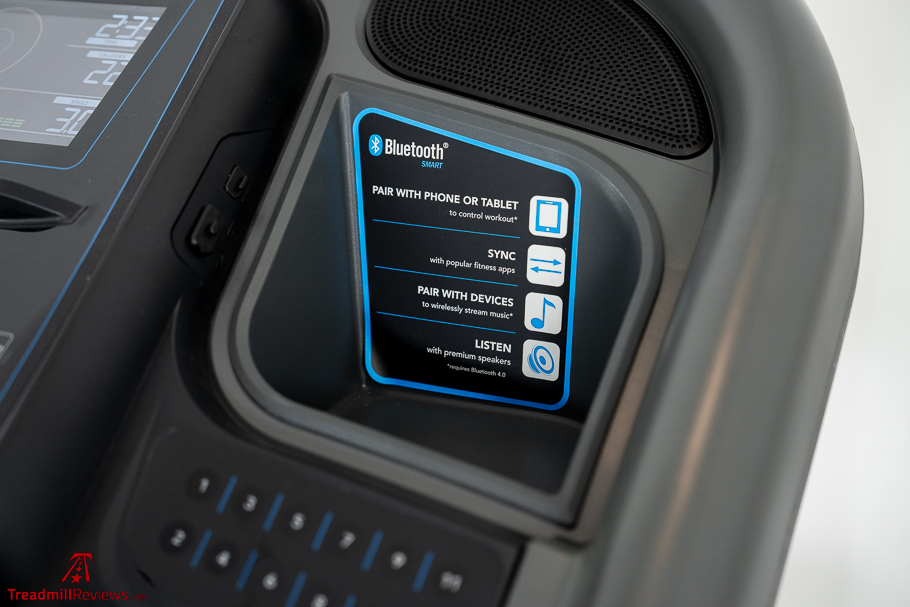
Heart Rate
The Sole F80 and the Horizon 7.4 AT have EKG pulse grips. They also connect with Bluetooth heart rate monitors. The Horizon 7.4 AT comes with a free Bluetooth heart rate monitor. However, I prefer the heart rate training options on the Sole F80.
Storage
These treadmills are pretty even when it comes to storage options. The Horizon 7.4 AT has two large but shallow cup holders. The Sole F80 has two moderately-sized cup holders and two small item storage compartments. The Horizon 7.4 AT has two tablet racks while the Sole F80 has one. You can also store your phone on the F80’s wireless charging pad.
Fan
Sole and Horizon have a similar weakness: their fans. You will likely need a floor or ceiling fan with either one of these treadmills.
Charging
The Sole F80 has a wireless charging pad. I like this option more than the USB charging port on the Horizon 7.4 AT, but check your phone to make sure it supports wireless charging.

App Connectivity
The Sole F80 has built-in apps, which I will discuss later, but it also connects with other apps. The F80 has a screen mirroring function that allows you to cast any content you would like onto the screen. As for the Horizon 7.4 AT, it has Bluetooth FTMS app connectivity, which allows it to share information with a range of fitness apps. I enjoy using Horizon treadmills to train with the Peloton app or Zwift.
Performance
The Sole F80’s firmer deck comes in handy for athletes concerned about their road running performance. Because there is not as much shock absorption and bounce, running on the F80 feels a lot more like running on the road. This means that your outdoor and indoor running paces are very similar. For this reason, I like the F80 for road racers who do a lot of their training indoors. The F80 is also very nice for long-distance running and training while viewing entertainment or instructional content.
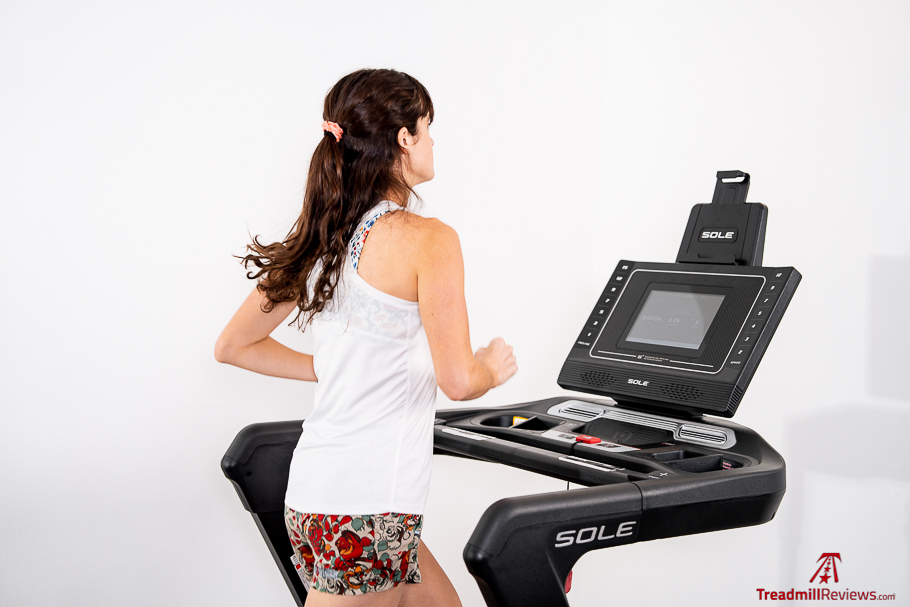
A soft running deck and the fast speed and incline transitions make the Horizon 7.4 AT ideal for recovery walks and runs and interval workouts. The 7.4 AT is also great for long distance training due to its motor size. The 15% maximum incline provides plenty of range for intense hill workouts. While the Horizon 7.4 AT doesn’t have the same range of onboard content that the Sole F80 has, it pairs well with fitness apps viewed on your phone or tablet.
Subscription & Content Options
Sole F80 Content
The Sole F80 is loaded with smart content. Starting with the preloaded workouts, there are intervals, custom workouts, fitness tests, and more. You can save any workout you complete as a template to repeat in the future. This is super convenient for users who have key workouts they go to often. There is one third-party training app from Kinomap, which has free and subscription-required features.
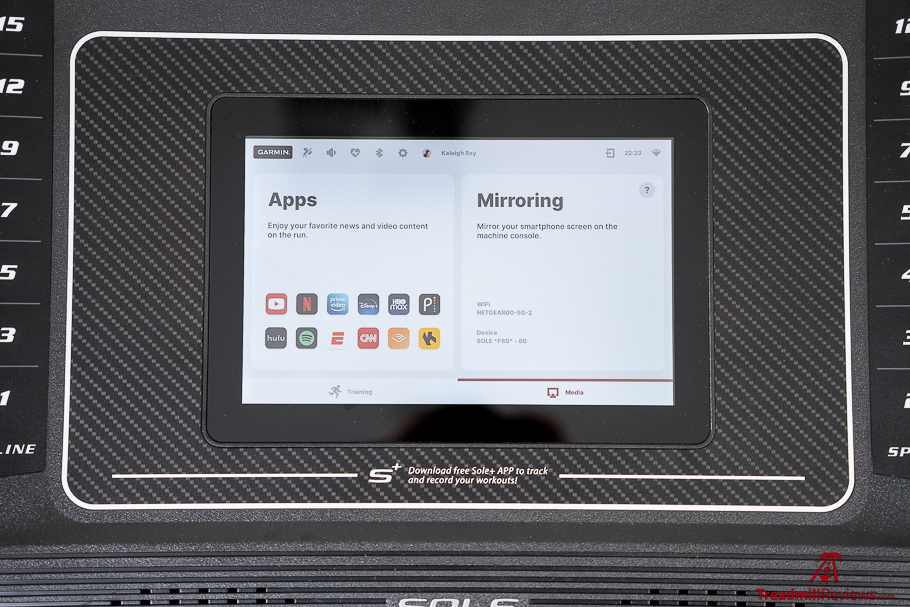
The other third-party apps available on the F80 are mainly entertainment streaming apps. Netflix, Hulu, Prime, Disney Plus, Max, Peacock, Spotify, Audible, ESPN, CNN, and YouTube are all available on the F80. Many of these apps require your own subscription to access, but Sole does not have its own subscription service to subscribe to.
If you want more content, you can pair your phone or tablet with the F80 for screen mirroring and Bluetooth audio. This lets you view just about any content you would like, but it does not automatically adjust the speed or incline. The F80 also works with Zwift. All in all, there are tons of content options without an additional required subscription.
Horizon 7.4 AT Content
The Horizon 7.4 AT Treadmill does not have a touchscreen display, so it has much simpler training options. There are 10 onboard workouts including the manual workout. You can set your time, maximum speed, and maximum incline for these workouts. The 7.4 AT also pairs with some apps. The QuickDial controls allow you to keep up with just about any content you could view on your phone or tablet easily. I really like training with Peloton on the Horizon 7.4 AT, because the speed and incline adjustments are so similar.
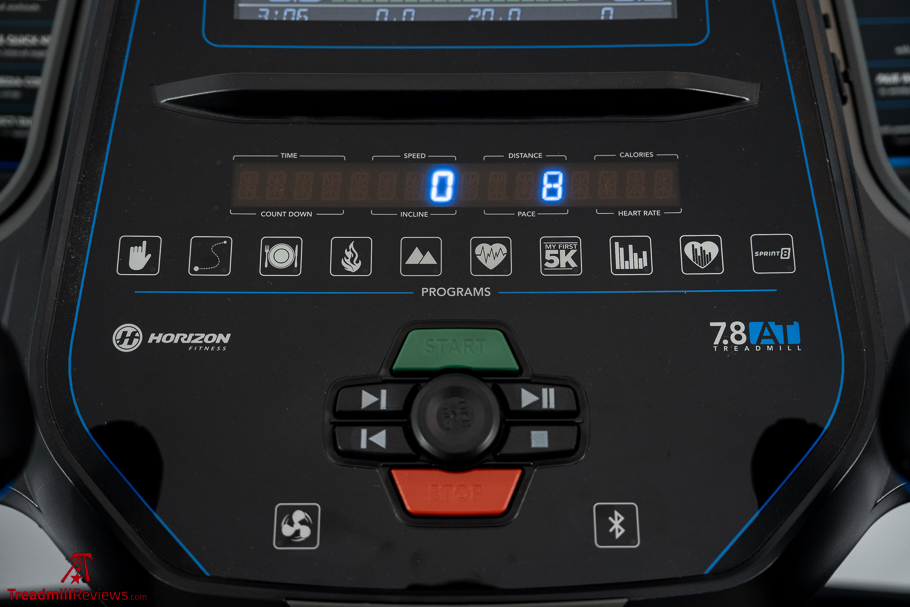
If you are looking for a treadmill that’s easy to use, the Horizon 7.4 AT’s relatively low-tech design is a great choice. It’s subscription free and has some app connectivity. I like it for walkers and runners who do not need very much training guidance.
Bottom Line Review: Sole F80 vs Horizon 7.4 AT
The Sole F80 treadmill has a modern build with a touchscreen display. The touchscreen is preloaded with training content and streaming apps. The Horizon 7.4 AT has a solid construction with simpler training content. Neither treadmill requires a subscription. The F80 and 7.4 AT are powerful treadmills that support everything from walking to long-distance running. It’s hard to identify a clear winner between the Sole F80 and the Horizon 7.4 AT. The F80 is best for runners looking for high-tech features and extensive training and entertainment content. The Horizon 7.4 AT is the better option for users who just want a sturdy treadmill regardless of the offered training content.
Read More Popular Treadmill Reviews:

